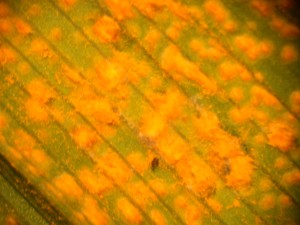 Daylily Rust, or Puccinia hemerocallidis, was recently diagnosed on a (you guessed it) daylily by the TPDD Lab. This rust is a fungus that only infects daylilies, and was first identified in the U.S. in 2000. Since it’s introduction into the States, widespread shipping of plant material throughout the country has moved the pathogen to over 30 states, including Texas!
Daylily Rust, or Puccinia hemerocallidis, was recently diagnosed on a (you guessed it) daylily by the TPDD Lab. This rust is a fungus that only infects daylilies, and was first identified in the U.S. in 2000. Since it’s introduction into the States, widespread shipping of plant material throughout the country has moved the pathogen to over 30 states, including Texas!
True to its name, Daylily Rust creates obvious symptoms on the leaves of the plant; the yellow to brown streaks on the surface of the plant resembles a rust like you might see on an old car. What you are seeing are actually called pustules, that grow and eventually release dusty, orange colored spores. These spores can be spread easily by wind or by human movement of plants. Daylily Rust goes through a complex life cycle, which includes infecting a different plant, a perennial in the Patrina species, before it can return to the daylily. Daylily Rust also produce 5 kinds of spores throughout its lifecycle. The urediospores are the orange, powdery spores shown below, and are of most concern with daylilies and Daylily Rust.
 The severity of Daylily Rust varies with daylily cultivar, and prevention can be attained by practicing good sanitation and using fungicides. Below is a link with more information on Daylily Rust, as well as a list of some resistant varieties of daylilies. Happy Gardening!
The severity of Daylily Rust varies with daylily cultivar, and prevention can be attained by practicing good sanitation and using fungicides. Below is a link with more information on Daylily Rust, as well as a list of some resistant varieties of daylilies. Happy Gardening!
http://plantclinic.cornell.edu/FactSheets/daylily%20rust/daylilyrust.htm


